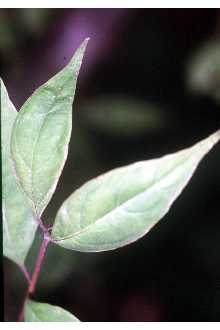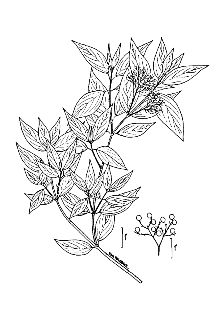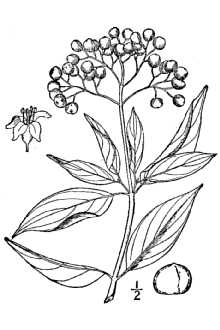Swida foemina (Mill.) Rydb.
Scientific Name: Swida foemina (Mill.) Rydb.

| General Information | |
|---|---|
| Usda Symbol | SWFO |
| Group | Dicot |
| Life Cycle | Perennial |
| Growth Habits | ShrubTree, |
| Native Locations | SWFO |
Plant Guide
Use a soil moisture meter to monitor the soil moisture where Swida foemina (Mill.) Rydb. is planted.
Fact Sheet
Uses
Wildlife: Fruits are eaten by several species of birds including quail, catbirds, mockingbirds, robins, and brown thrashers. Recreation and Beautification: Excellent landscape tree for its very attractive form and profuse white flowers. Frequently used for massing or naturalizing, screen and border.
Status
Please consult the PLANTS Web site and your State Department of Natural Resources for this plant’s current status (e.g. threatened or endangered species, state noxious status, and wetland indicator values).
Description
Cornus foemina P. Mill., swamp dogwood, is primarily found along the coastal plain from eastern Virginia to central Florida, west to Louisiana and north to southeastern Missouri. It is a deciduous small tree to large shrub, growing to 15 ft in height, with multiple trunks, 4 inches in diameter. Its bark is thick and smooth, frequently furrowed with shallow ridges exposing gray inner bark. The plant’s leaves are opposite and oval-shaped, with smooth margins. Flowers are creamy white, loose, and small; they occur in flat topped clusters without showy bracts. Fruits are small, open clusters of bluish to purple drupes (fleshy, one-seeded fruits). Robert H. Mohlenbrock USDA, NRCS 1995 Midwestern Wetland Flora @ USDA NRCS PLANTS
Adaptation and Distribution
Distribution
Distribution
Swamp dogwood generally grows in swampy, low wetland habitats, barrier islands, and along streams, riverbanks, marshes and creeks. It is found growing along ditches on the second road back from the ocean at Emerald Isle and found to exhibit moderate salt tolerance. Swamp dogwood is distributed throughout most of the southeast United States. For a current distribution map, please consult the Plant Profile page for this species on the PLANTS Website.
Establishment
Like most dogwoods, this species can be grown easily from seeds collected from mature, native trees and from softwood cuttings. Seeds at maturity must be either planted immediately or prechilled. Seeds sown in nursery beds should be covered with ¼ to ½ inch of soil and mulched during the winter.
Management
Plant in moist soils in full sun to partial shade as it is tolerant to wet and/or low fertility soils, It requires little maintenance in naturalized settings, When used for massing, pruning to within a few inches of the ground every few years promotes fullness, , Use soil moisture sensors to measure the soil moisture of Swida foemina (Mill.) Rydb..
Plant Traits
Growth Requirements
| Temperature, Minimum (°F) | -3 |
|---|---|
| Adapted to Coarse Textured Soils | No |
| Adapted to Fine Textured Soils | Yes |
| Adapted to Medium Textured Soils | Yes |
| Anaerobic Tolerance | Medium |
| CaCO3 Tolerance | Low |
| Cold Stratification Required | Yes |
| Drought Tolerance | Low |
| Fertility Requirement | Medium |
| Fire Tolerance | Medium |
| Frost Free Days, Minimum | 240 |
| Hedge Tolerance | Low |
| Moisture Use | Medium |
| pH, Maximum | 7.2 |
| pH, Minimum | 5.8 |
| Planting Density per Acre, Maxim | 1700 |
| Planting Density per Acre, Minim | 1200 |
| Precipitation, Maximum | 60 |
| Precipitation, Minimum | 36 |
| Root Depth, Minimum (inches) | 16 |
| Salinity Tolerance | None |
| Shade Tolerance | Intermediate |
Morphology/Physiology
| Bloat | None |
|---|---|
| Toxicity | None |
| Resprout Ability | Yes |
| Shape and Orientation | Erect |
| Active Growth Period | Spring and Summer |
| C:N Ratio | Medium |
| Coppice Potential | No |
| Fall Conspicuous | Yes |
| Fire Resistant | No |
| Flower Color | White |
| Flower Conspicuous | Yes |
| Foliage Color | Green |
| Foliage Porosity Summer | Moderate |
| Foliage Porosity Winter | Porous |
| Foliage Texture | Fine |
| Fruit/Seed Conspicuous | Yes |
| Nitrogen Fixation | None |
| Low Growing Grass | No |
| Lifespan | Moderate |
| Leaf Retention | No |
| Known Allelopath | No |
| Height, Mature (feet) | 16.0 |
| Height at 20 Years, Maximum (fee | 16 |
| Growth Rate | Moderate |
| Growth Form | Thicket Forming |
| Fruit/Seed Color | Black |
Reproduction
| Vegetative Spread Rate | Moderate |
|---|---|
| Small Grain | No |
| Seedling Vigor | Medium |
| Seed Spread Rate | Moderate |
| Fruit/Seed Period End | Fall |
| Seed per Pound | 12000 |
| Propagated by Tubers | No |
| Propagated by Sprigs | No |
| Propagated by Sod | No |
| Propagated by Seed | Yes |
| Propagated by Corm | No |
| Propagated by Container | Yes |
| Propagated by Bulb | No |
| Propagated by Bare Root | Yes |
| Fruit/Seed Persistence | Yes |
| Fruit/Seed Period Begin | Summer |
| Fruit/Seed Abundance | Medium |
| Commercial Availability | Routinely Available |
| Bloom Period | Mid Spring |
| Propagated by Cuttings | No |
Suitability/Use
| Veneer Product | No |
|---|---|
| Pulpwood Product | No |
| Post Product | No |
| Palatable Human | No |
| Palatable Graze Animal | Low |
| Palatable Browse Animal | Medium |
| Nursery Stock Product | No |
| Naval Store Product | No |
| Lumber Product | No |
| Fodder Product | No |
| Christmas Tree Product | No |
| Berry/Nut/Seed Product | No |



